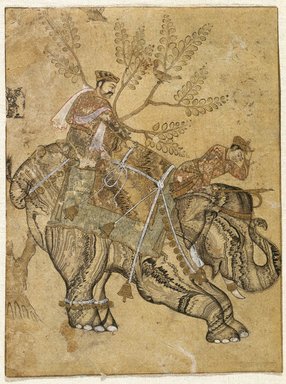
Artist:Indian
Medium: Ink, gold and watercolor on paper
Geograhical Locations:
Dates:mid 17th century
Dimensions: Sheet: 6 1/2 x 4 7/8 in. (16.5 x 12.4 cm)
Collections:
Exhibitions:
Accession Number: 2002.38
Image: 2002.38_IMLS_SL2.jpg,
Catalogue Description: The mahout seated on the rear of the elephant sports a long moustache with fine shadowing of beard on his face, his right arm extended and the index finger hooked around the rope which holds the saddle cloth in place. A younger mahout seated in front, with delicate features, leans over the elephant's head, a goad in his right hand and his left arm raised with his hand held against his forehead indicating that he is directing the elephant to take a bow. This action is evidenced by the elephant's pose with forelegs outstretched and trunk raised. The beast is adorned with bells on chains, suspended from long ropes across his body. The Stalling Elephant with Two Riders is a tour de force of the marbler's art, representing a fleeting tradition in Deccani painting. According to the analysis by Christopher Weimann, the marbled areas of this painting were produced by means of four stencils, one for the figures' robes, one for the upper saddle cloth, one for the lower saddle cloth, and one for the elephant. Not only do the colors of each marbled passage vary but also the direction of the marbling contrasts from section to section. As Weimann notes, the patterns formed by the marbling heighten the sense of movement and define the contours of the elephant's body. The tree and birds in the background, the figures' faces, and the bells, ropes, and shawls were all painted and highlighted with gold once the marbling was complete. While the riders' faces conform to mid-seventeenth-century Mughal norms, the evidence available on marbled paintings of the seventeenth century strongly supports an attribution of the group to a Deccani workshop, probably located at Bijapur.